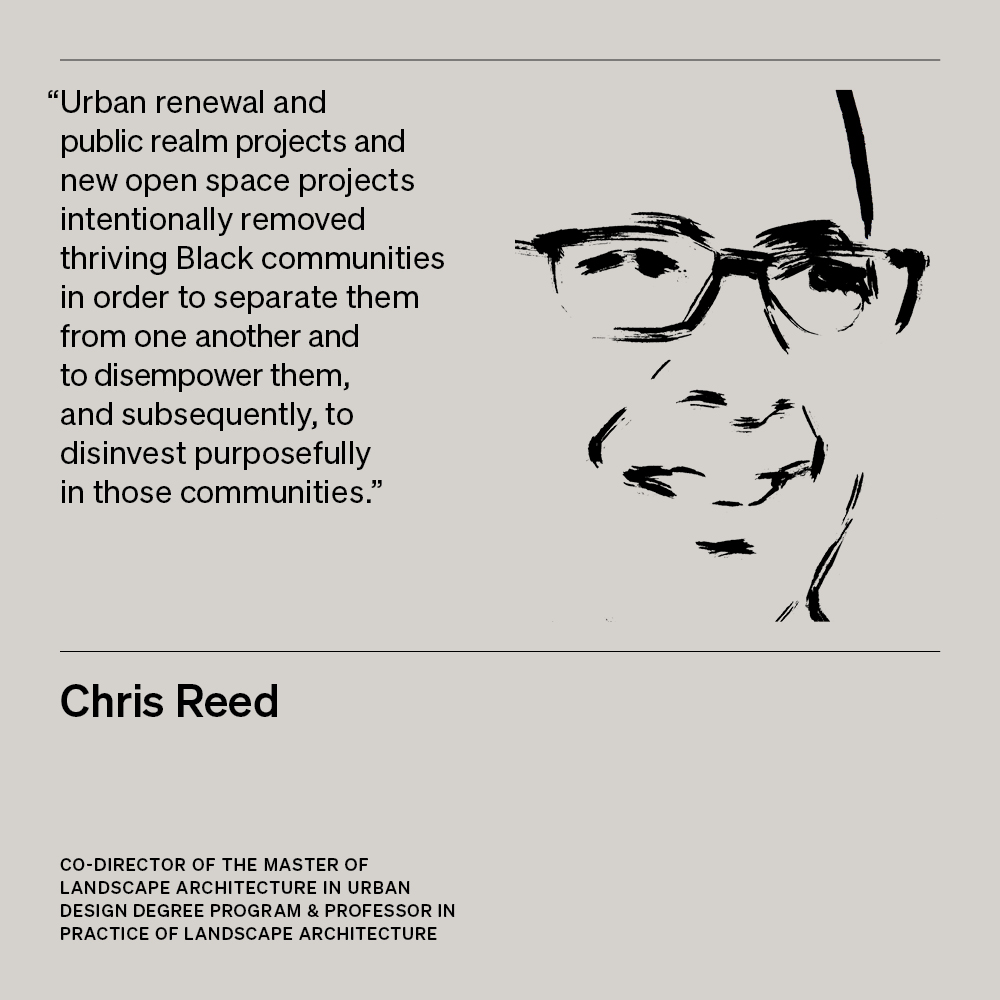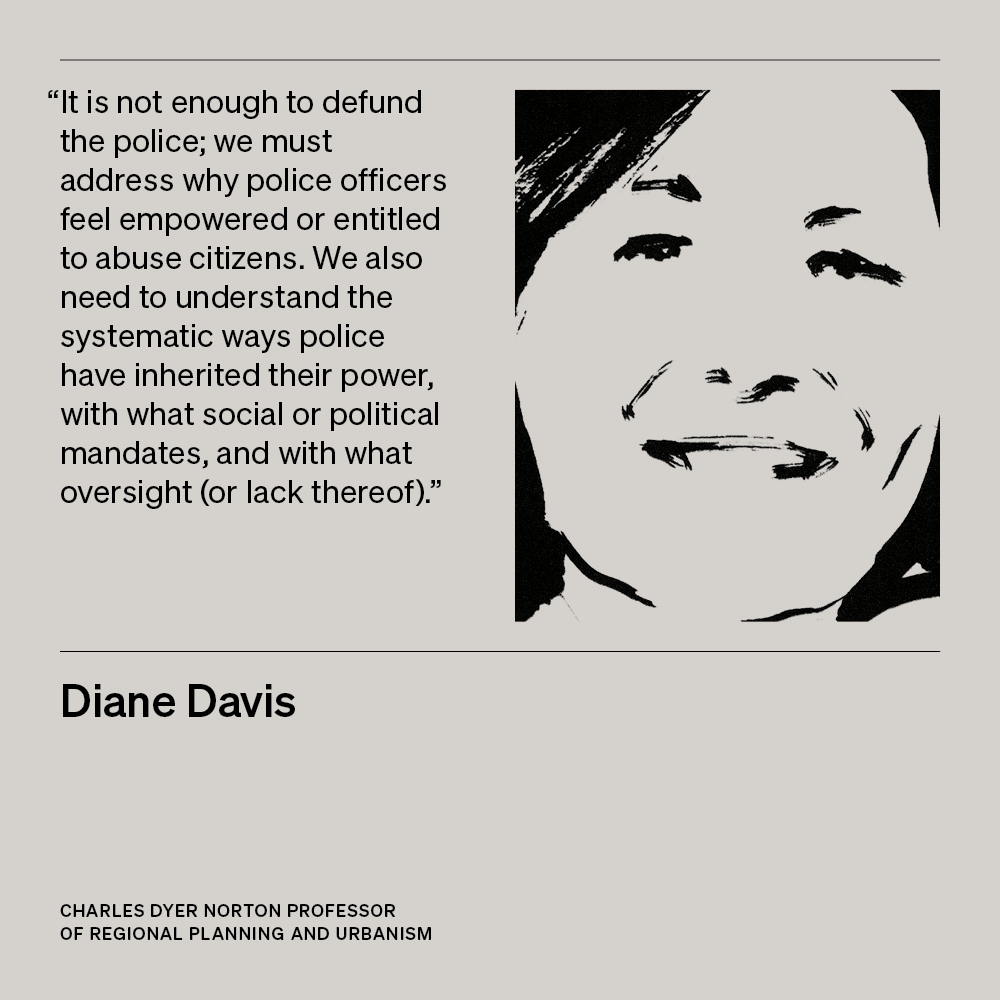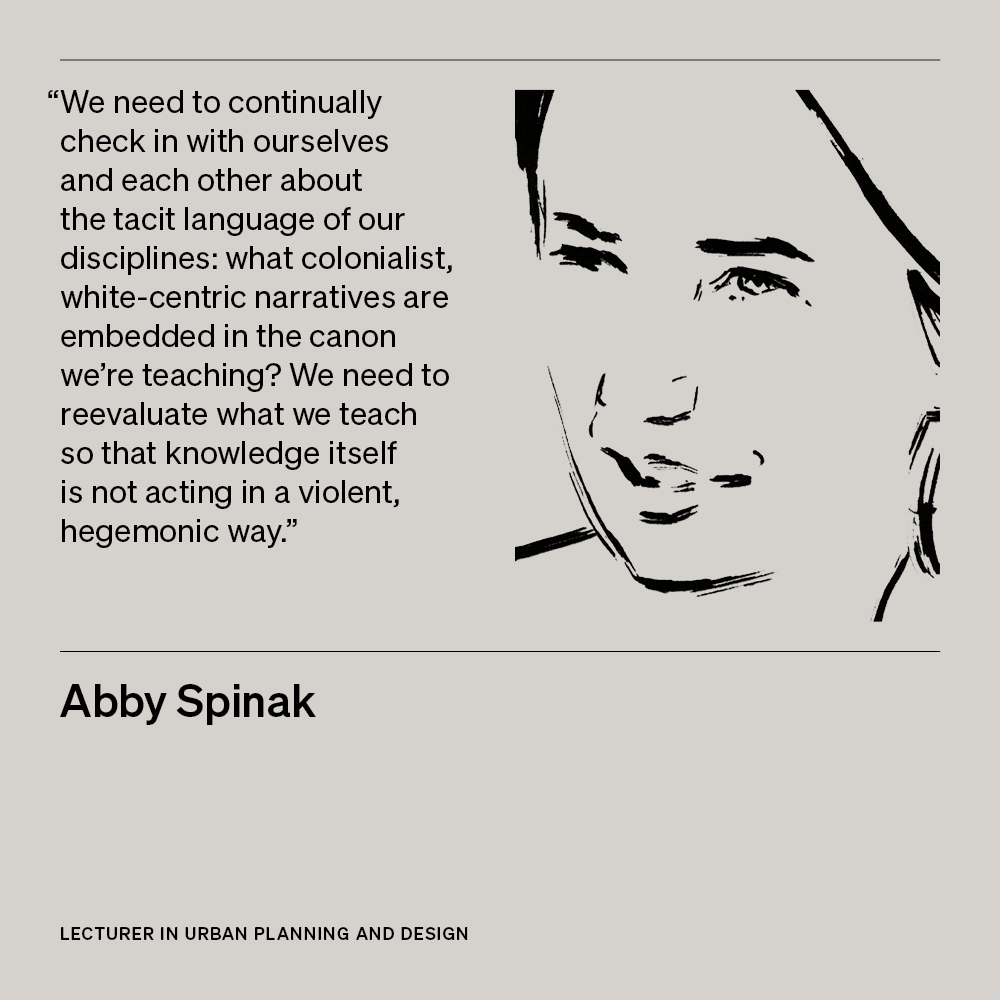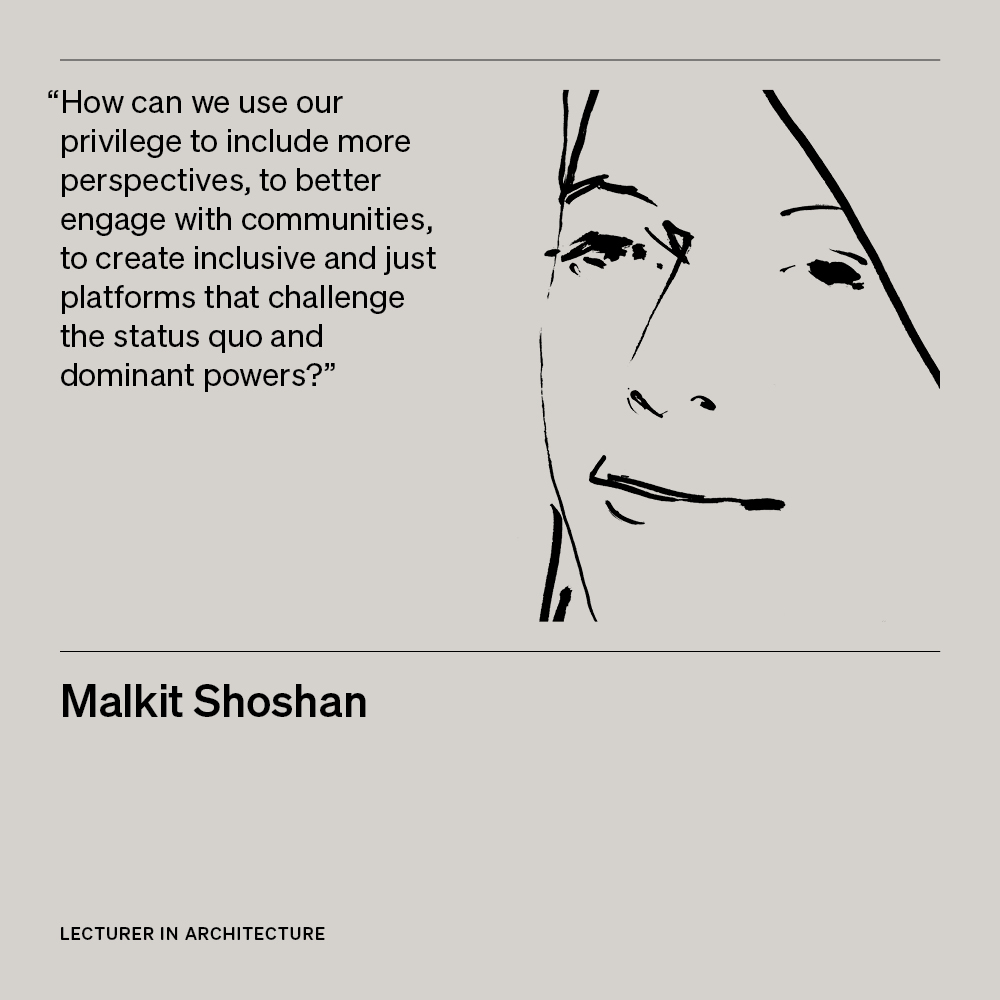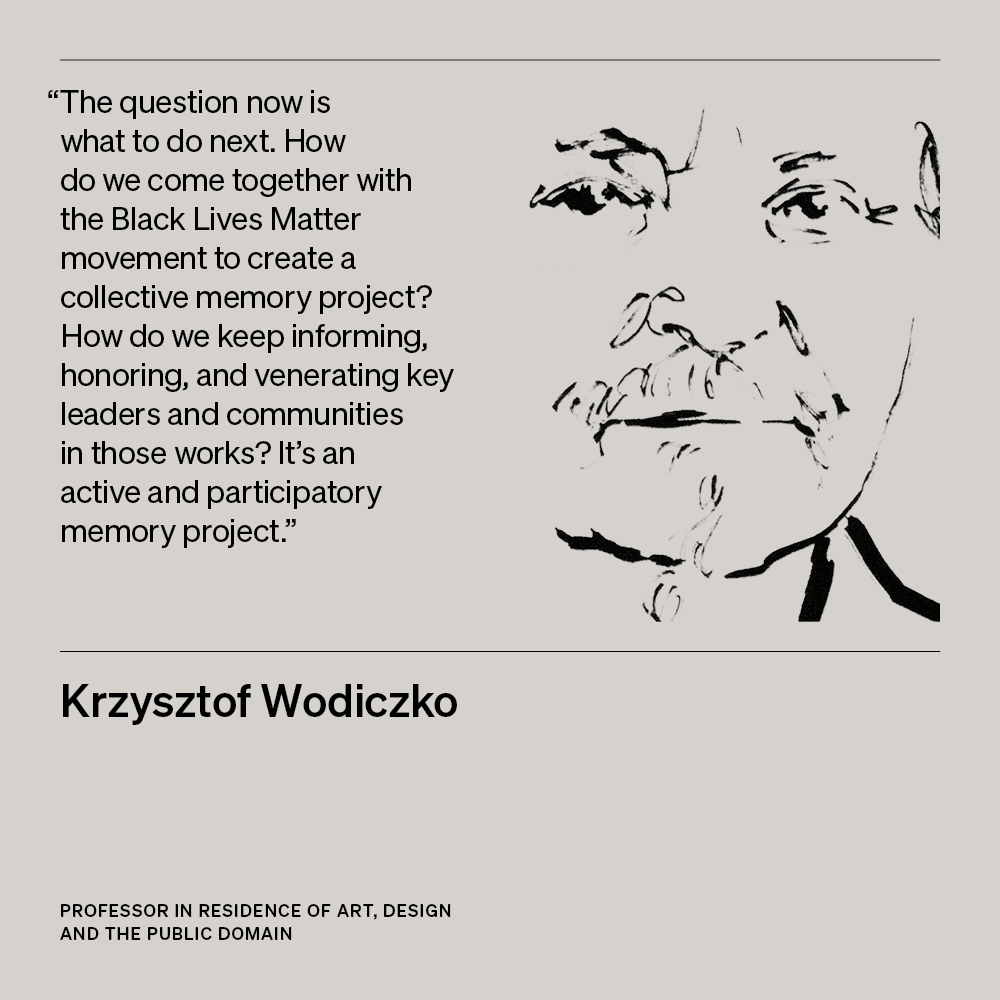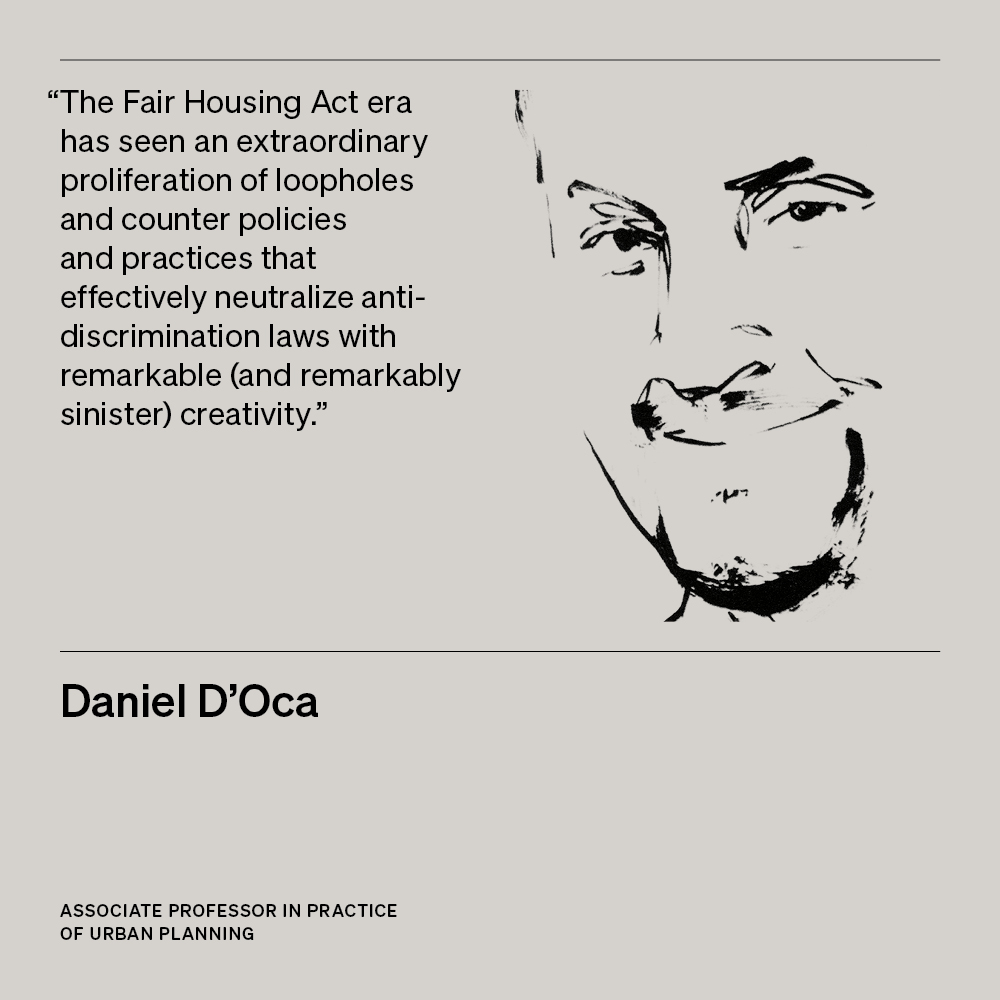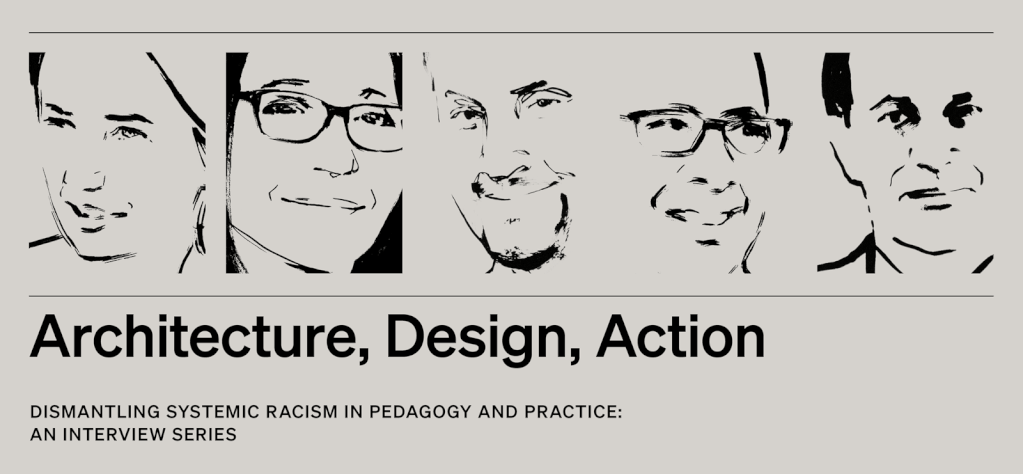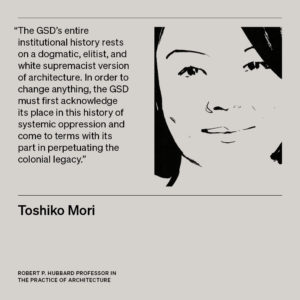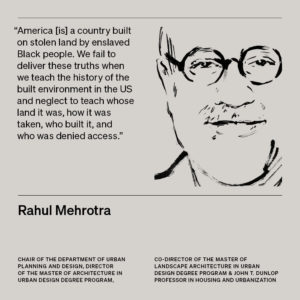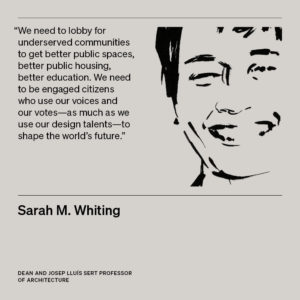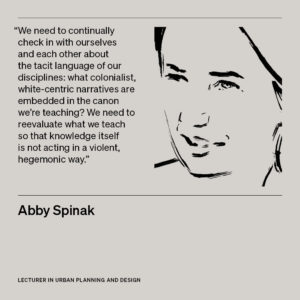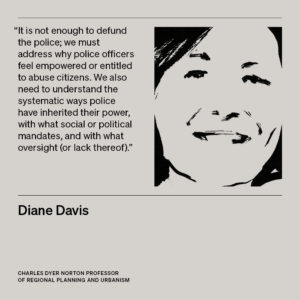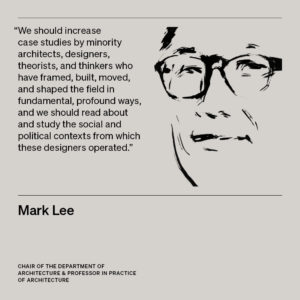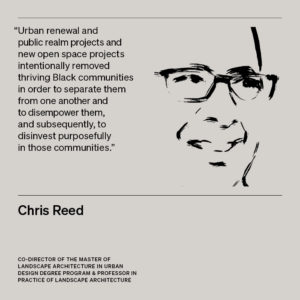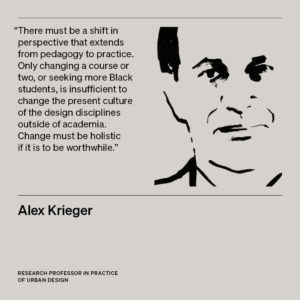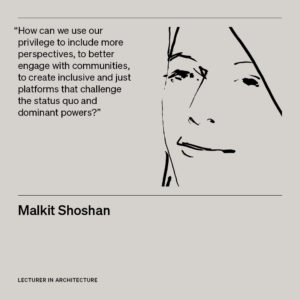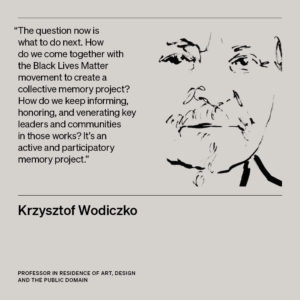Architecture, Design, Action: Chris Reed on Dismantling Systemic Racism in Pedagogy and Practice
Chris Reed, Co-Director of the Master of Landscape Architecture in Urban Design Degree Program & Professor in Practice of Landscape Architecture
How has the discipline of landscape architecture enabled a history of spatial injustice and violence against Black Americans?
Open space and landscape/planning practices have been used to segregate and oppress Black populations in cities across America for decades. Urban renewal and public realm projects and new open space projects intentionally removed thriving Black communities in order to separate them from one another and to disempower them, and subsequently, to disinvest purposefully in those communities. We can also see, in the last couple of decades, the imbalance of investment in open spaces in white communities and Black communities—and the ways Black and minority communities near signature projects have not been included in their design and planning nor in reaping their benefits. We must acknowledge this disciplinary history as a start, and we can then begin to have an open and more honest conversation pedagogically and professionally.
How can landscape architects be better allies to, and advocates for, communities of color, particularly Black communities?
This is a very important question. I can really only speak from my own experience as a practitioner. My firm, Stoss, works typically in the public realm, and we confront these issues of race and social equity on a daily basis. When you’re working on public projects you engage many communities of color, and you can and should give those communities a real voice and influence in the work. Our practice has been involved in many projects that put issues of equity, race, and social justice at the center of their agendas, and make racial and social equity an essential outcome of that work.
In our recent work in St. Louis on the Chouteau Greenway , for instance, we put together an incredibly diverse team of nationally recognized and local consultants, including Toni Griffin and recent Loeb Fellow De Nichols. The Greenway project was intended to address St. Louis’s racial issues square on and to find ways forward that would change the way the city works, change the way design projects and practices are developed, and change the nature of civic conversation in the city. That’s a big challenge for any design discipline—but it’s one that landscape architecture is well suited to, given the impact that landscape projects have physically, geographically, socially, and economically across many different neighborhoods and cultures. In such instances, we work deeply with African American communities and many other communities of color to draw on their experiences and their own social and cultural histories and traditions as ways to begin to inform the work that we do—and that then are manifest in the programming and design.
When we do this, the projects become richer. They have broader appeal when people can begin to see in the work their own cultural histories and references. It takes a certain humbleness on our part, knowing that we don’t have all the answers. If we do it right, this kind of open process results in a set of designs that are powerful and empowering, and advance design ambitions and agendas as much as they advance social-cultural agendas. But it’s important to listen in the right ways, to assemble the right teams, to build trust in those communities, and to start with questions, not answers. Even in projects where we’re not being asked to take on these issues directly, it’s up to us as designers to advocate for the voices who aren’t in the room and who don’t yet have a seat at the table. We can expand the possibilities and the audiences for a project and counter built-in, structural, anti-Black racism that continues to pervade many forms of city-making and design.
Practitioners can model practices that help to address racial issues, even when our projects do not. We can develop partnerships with local organizations that deal with issues of race, equity, social and environmental justice, youth, art, etc., and provide pro bono design and planning services to them and the communities they serve. We can donate to the organizations we work with in our own communities, and in the communities we work in across the US, as we are doing at Stoss. We can host Black thinkers and designers for forums and discussions with our staff. We can advocate for many causes, including making Juneteenth a state and national holiday, and for Black rights in general. We can showcase the work of Black creatives, as Sean Canty has done so powerfully . And we can implement new opportunities for firm-supported community service; at Stoss, Juneteenth will be a paid day off for staff who want to take on a community service initiative that day.
How else can landscape architecture education help dismantle white supremacist narratives?
It’s important that we first acknowledge that the experience of Black Americans is singular—beginning with slavery, and then with the lingering effects of slavery, racism, and racial violence that persist today. No other people have endured a history of violence as Black people in the US have. Our work—and diversity initiatives generally—need to be broad, but they need to acknowledge that African Americans have a singular experience in the US that no other race has shared; we need to respond to this clearly and directly.
In the department, we’re looking at a number of initiatives, including revising the curriculum; recruiting more Black faculty, students, and administrative staff; and continuing to build upon our recent efforts in the history and theory courses to include topics and resources beyond white, Eurocentric sources. We will see clear results starting in the fall, especially if we expand this work to studios and seminars.
For a number of years, in my courses, I’ve been trying to include project references from many different cultures around the world, to ask “who are we (or should we be) designing for,” and to very directly take on hard questions of race in the city. Recently, for instance, Sean Canty, Lily Song, and I taught “Multiple Miamis,” an option studio in the Overtown neighborhood of Miami, an African American community. We began with questions of how design could best serve the community members that are already there, before it begins to imagine amenities that could attract new populations.
Much of the departmental conversation focuses on how we can expand these practices and efforts and initiatives in both the short and long term. How do we expand resources that help support this work? And how do we create a culture that brings more Black and brown people into the school in meaningful ways—in positions of authority, on the faculty—who can contribute their intellects, their cultural and social traditions, and their own life experiences in order to have more open and more diverse conversations about the agency of design.
Creating a community of people who look like each other and who can share life experiences will also help with student recruitment. The more that we can have diverse Black faculty, the more we can begin to develop a culture that’s going to naturally attract more Black students and provide a community that they can respond to.
What kind of conversations have the Notes on Credibility and subsequent responses from the dean and faculty generated in your department?
The Notes caused a lot of people to reflect deeply on the broader cultural moment we are in and the issues specific to the GSD—it’s a very helpful and necessary critique of our institution. The students behind the Notes were able to articulate something very clear—it was a tough message for many people, but one that rang true—and you could sense the students’ passion and frustration. They weren’t just raising issues, they also outlined very tangible actions for moving ahead, which is incredible.
The responses we’ve seen so far from the dean and different departments are a good first step. The dean’s response, in particular, was heartfelt. You could read the humanity behind it, but also the intellectual project at hand. Across the faculty, it’s been a deeply reflective conversation, and what we’ve uncovered through it is the need to take quick steps forward, in a thoughtful way, in combination with more long-term actions. We all feel the urgency and opportunity of the moment to rethink how we teach, and how our academic lives are structured, how we recruit, all of that. I think the Notes have generated more focused conversation on a single topic or set of topics than anything else in the recent past at the GSD—and the students are to be lauded for this.
How can the GSD begin to diversify its faculty, particularly in terms of younger Black architects and designers showing excellence in their profession but without a pre-existing teaching record?
We need to do multiple things simultaneously. We need to recognize the world-class Black researchers and designers who are already out there—and not just because they focus on Black issues, but because they are outstanding academics and designers who just happen to be Black. We also need to find ways to cultivate more relationships with these scholars and practitioners and double down on our efforts to bring them into the GSD.
In Landscape Architecture, we were fortunate this year to bring in a new faculty member, Sara Zwede, who’s African American. She is well recognized already as a young designer, urbanist, and artist and has an excellent body of emerging research about the South called Cotton Kingdom (also the name of the seminar she’ll be teaching in the fall). Finding folks like Sara at all levels of our faculty is important. It will take a commitment of energy and resources to develop such recruitment initiatives and teaching programs, but it will be time well spent.
How can the GSD reshape its pedagogical approach?
Again, to go back to the “Multiple Miamis” studio, the school raised money through the Knight Foundation to do a series of studios in Miami that dealt with issues of race, social equity, and climate displacement. Those sorts of GSD-sponsored initiatives are absolutely critical. It’s all too easy to say that we’ll take on a problem in Cambridge, St. Louis, Miami, or Los Angeles: We’ll do an event in an impoverished area, meet the folks struggling with these issues, and then we go away and develop our own academic projects. We must also find a way to give something back to these communities so we’re not just drawing on their experience and knowledge to develop our own work. It could be using the GSD’s convening power to put community advocates and power brokers into the same room, so we can contribute to and advance the issues on the ground, or it could be offering scholarships to programs like Design Discovery for kids in these communities. The goal is to find or make opportunities for reciprocal learning and benefit so that we are good stewards as well as good students.
Chris Reed is founding director of Stoss Landscape Urbanism, and Professor in Practice of Landscape Architecture and co-director of the Master of Landscape Architecture in Urban Design Program at the GSD. He is interested in the relationships between landscape and ecology, infrastructure, social spaces, and cities—and in foregrounding issues of race and equity in the firm’s projects.
Architecture, Design, Action: Diane Davis on Dismantling Systemic Racism in Pedagogy and Practice
Diane Davis, Charles Dyer Norton Professor of Regional Planning and Urbanism
Why is it important to understand the history and origins of systemic racism perpetuated through urban planning?
Planners, by their very nature, focus on the future, and are concerned with how to make things better. Sometimes these commitments make them overly technocratic. Insights from the humanities and social sciences can help push back against these tendencies. They also can reveal the ways that planning actions in the past have actually produced the problems we try to correct today, including systemic racism.
I say this as a sociologist working mostly on similar questions in the developing world. I’m originally from St. Louis, though, a city that’s very divided by race and space. Its endemic racial injustices reflect institutional legacies of the Civil War and historical struggles over sovereignty. So what looks like community-level, routine police abuse of power is actually rooted in the systemic racism that was a product of that time. To properly dismantle racist structures in American cities and elsewhere, we need to know exactly how we built them.
Planners also generally have some degree of social awareness because part of the job is to think about class, inequality, race, and power. You can’t solve problems with just spatial interventions; you need to understand the actors and institutions that keep people apart in space.
As a professor of urban planning, how do you respond to the increasingly popular call for abolishing the police?
It is not enough to defund the police; we must address why police officers feel empowered or entitled to abuse citizens. We also need to understand the systematic ways police have inherited their power, with what social or political mandates, and with what oversight (or lack thereof). Most societies want institutions that guarantee social order and protect citizens. If that is not happening, and certain populations are suffering disproportionately, then there is something wrong with the police institutions and the social contract upon which they are founded.
I see people pushing for police reform in the United States, but from my studies in Mexico, and also looking at conflicts in Israel and Palestine, where police violence is used to spatially separate people, officials constantly call for reform. But more often than not, reform cannot solve endemic structural problems. It is likely that police are incapable of reforming themselves, because institutionalized norms that govern their behavior are often part of the problem.
This means that others must be involved. Communities on the front lines need to lead security efforts—with an understanding of safety and justice that comes from their own experiences and not from outside interpretations. We must continue to ask how much of any community’s security should really lie in the hands of the police, as opposed to with the communities themselves. What co-policing institutions and practices would guarantee citizen security without sacrificing equity and justice?
What should all students, regardless of department, leave the GSD knowing about?
Our programs should place more emphasis on the history of American cities, and on why they look the way they do. Even though we are an international university, we are located in the US and such knowledge would be a good way to ground a conversation across our varied disciplines. More generally, all planning, urban design, and architecture students should be taught to think about the institutions that create the spatial conditions in which we are designing. When I say “institutions,” I refer to social, political, and economic institutions, ranging from states to markets, and how or why they may impose certain regulations, incentivize certain actions, or normalize certain values.
In the US, most of the institutions we live with—many of which emerged out of the struggle over race—embody some form of political arrangement or compromise. This includes certain zoning or land-use regulations. To understand some of the contemporary problems we are facing with respect to race-based inequality and oppression at the hands of police, students—including architecture students—must understand the history of zoning and when it is used to isolate people of color. All disciplines at the GSD should be asked to study the history of governing and legal institutions relevant to the design world.
What can planners do better? What role do they have in fighting for more just cities?
To create equitable and just cities, we need to think about them both socially and spatially. Planners should be well prepared to keep both these dimensions in mind. While urban designers often think about what constitutes a vibrant or equitable community in spatial terms, planners are inclined to think about the social relationships that create strong and equitable communities. At the GSD, we are in a particularly privileged position to move beyond these dichotomies and work on both fronts simultaneously. If we want to transform cities, we need to improve our pedagogy to generate horizontal conversations and strengthen connections among the various design disciplines, including architecture.
In my own writings, I have been thinking about the need to champion urban sovereignty, or reciprocal governance at the scale of the city, in ways that might enable every resident to feel included or recognized as a member of an urban “imagined’ community of allegiance. With such a commitment, all residents would be asked to become collectively responsible for defending, shaping, and transforming the city they share, but in a more just and equitable way.
Cities are hotbeds of diversity and, precisely because of that, I am hopeful that what might unite people at the scale of the city is going to be more inclusive and humane than what people share at the scale of the nation. We cannot leave identity-formation or repertoires of reciprocity only to state and federal authorities, particularly when they are incapable of understanding the complexities of urbanism and seek to divide urban residents rather than unite them.
We need planning and design strategies that move us beyond the worst excesses of nationalism and militarized exclusion that manifest at the scale of the city. Whether these excesses involve the use of the National Guard to police street protesters, or whether they come in the form of federal policies that distribute funds to states without accounting for differences in their urban populations, we must ask whether these responses show sufficient knowledge of cities, the challenges they face, and how people actually live in them. By focusing attention on urban sovereignty, we may be able to push back against such practices.
I would also hope that any such endeavor might help transcend binaries of difference that are frequently exposed in cities, whether based on race, ethnicity, class, gender, or neighborhood. With socio-spatial practices and sensibilities that foster shared allegiances—both in physical and spatial terms, as well as through resources and recognition—it will be clear that we are all in this together, and that moving forward collectively is the best way to build more just and equitable cities.
Diane E. Davis is the Charles Dyer Norton Professor of Regional Planning and Urbanism and chair of the Department of Urban Planning and Design. She is Area Head of the Risk and Resilience MDes area group. Trained as a sociologist, Davis researches the relationship between urbanization and national development, comparative urban governance, socio-spatial practice in conflict cities, urban violence, and new territorial manifestations of sovereignty.
Architecture, Design, Action: Abby Spinak on Dismantling Systemic Racism in Pedagogy and Practice
Abby Spinak, Lecturer in Urban Planning and Design
From an urban planning perspective, how has the coronavirus pandemic challenged and reshaped cities as democratic spaces?
One of the prominent public narratives early on was that the protests would cause superspreading events. But by and large the same people protesting are also the ones advocating for social distancing and for more government accountability on suppressing the spread of COVID. This movement should be taken even more seriously because the people out there know the risks and are protecting each other to mobilize during a pandemic that is disproportionately affecting Black people. This, and of course the curfews and escalating police violence, show how both highly politicized and absolutely necessary urban public space continues to be, even in a pandemic.
How can planners leverage their skills to better serve the communities of color they’re supposed to represent?
The field of planning can learn a lot from Black activists and scholars about how to expand our basic conception of what’s possible, what growth means, and who gets to determine the path of evolution of the built environment and of our institutions. There are a lot of alternative future visions that activists and theorists have developed—planning as a discipline needs that diversity of futures. We can achieve it by listening to the conversations and work of these activists and including them in our teaching. It will also require an intense, no doubt painful, period of self-reflection, of understanding the true breadth of exclusion in planning education alongside other architecture and design disciplines. There’s a point where you have to ask, Beyond getting a seat at the table, who gets to design the table?
What about educational reform at the GSD?
We can learn so much from our students. Toni Griffin and I recently co-advised a student, Natasha Hicks, whose thesis questioned what it would look like to rebuild design education from a position of Black radical feminism. She started from the perspective that people come to learning with different expectations, and you need to meet them where they are. How do you develop a pedagogy for these different groups? Where do you start the conversation? What narrative tools do you need? What should they be reading?
In the short term, we must make sure that our syllabi reflect diverse voices and perspectives. I remove more white male authors from my syllabus every year. We need to continually check in with ourselves and each other about the tacit language of our disciplines: what colonialist, white-centric narratives are embedded in the canon we’re teaching? We need to reevaluate what we teach so that knowledge itself is not acting in a violent, hegemonic way.
In the hallowed halls of old institutions like the GSD, we are good at showing solidarity without necessarily turning that gaze on ourselves. It’s one thing to amplify voices, but maybe amplification in this context means that we, the white faculty, should shut up and listen.
Abby Spinak is lecturer in Urban Planning and Design and area head in the Risk and Resilience MDes area group. Spinak studies the history of “energy democracy.”
Architecture, Design, Action: Malkit Shoshan on Dismantling Systemic Racism in Pedagogy and Practice
Malkit Shoshan, Lecturer in Architecture
As an architect in a multidisciplinary, research-based practice that works to uncover systemic inequity in the built environment and its regulatory bodies, can you begin by discussing your relationship with architecture and how architects can fight against oppression?
First and foremost, we need to ask questions rather than propose solutions. Architecture wants to provide answers to every problem, but it could be more productive to cut off this impulse. As architects, we’re trained to draw lines, build walls, and extract—whether it’s information or material resources. Instead of drawing lines, let’s think about what’s underneath them and what they are crossing.
Israel, where I was born and studied, operates on explicit politics of exclusion. Every architecture project can be considered an act of segregation, every masterplan brief I opened was a tool kit of implementing racism in the built environment. Every structure has a role in the historical and present dispossession of Palestinian communities, taking away land and cutting off access to resources. I can only really speak from my own experience of growing up amid this systemic segregation, but perpetuating it through my work was never something I would agree to, so starting when I was a student, I decided to change the way I engaged with architecture.
My architecture designs turned into research and experimentation with mapping, representation, and activism, which I later edited and published in Atlas of the Conflict: Israel-Palestine and Village: One Land Two Systems and Platform Paradise . These books critically examined Israel’s architectural and spatial strategy. It’s a country that has two doctrines: design for Israelis and design for Palestinians. The easiest way to describe it is that the former works on construction and the latter works on deconstruction. But both are intertwined—the destruction of Palestinian cities fortifies and enables the construction of additional Israeli settlements, and so on.
Both with my practice and with FAST , we aim to make visible how complicit architecture and design is in perpetuating segregation by uncovering these processes of colonization and dispossession. We look for opportunities to challenge institutions and empower the marginalized and the public imagination. We all have a duty to confront, criticize, and scrutinize the ways architecture is weaponized as a tool of inequality and exclusion and used to maintain hegemonic powers.
In your work with FAST you often talk about dismantling systems of power and segregation as a multi-scalar issue. Can you elaborate on that process?
One of FAST’s ongoing projects focuses on the impact United Nations peace missions have on cities, communities, and the environment. My interest in the architecture of the UN is institutional and topological. The UN is an important institution of global international cooperation, but it’s incredibly segregated and perpetuates the exclusive power of nation-states. Its peace operations generate the largest material and environmental footprint among all UN agencies, and they occur in areas with long legacies of violence, colonization, extraction, and systemic marginalization. All decisions regarding peace operations are led by the UN Security Council and are subject to the veto power of five nation-states: China, France, Russia, the UK, and the US.
It’s interesting to go into the belly of the beast to figure out how power works. When we started working with the individuals at the helm of such organizations, we realized that many of them have come from the field of activism and are motivated by good values. But we quickly discovered that these huge institutions and their personnel are so immersed in bureaucratic and administrative processes that they suffer from a systemic lack of imagination; they fundamentally cannot envision a different world. So how do you work with these UN staff members and empower them with tools to advocate for change in a superstructure so resistant to it? By using conceptual design—and never specific design, because ultimately you want them to think, and consequently change work culture, rather than follow yet another procedure—you can open up all kinds of nodes in the system and dissolve them.
Although it feels almost impossible to change the UN, we trying to penetrate this bureaucratic and overpowering monolith. For instance, peace missions are gigantic—a UN camp is often bigger than the city or village situated alongside it. We kept asking UN agencies, What happens with all of this material footprint throughout and at the end of each mission? What is the material legacy? These questions led to a conversation about the policy of “liquidation of assets” at the end of every mission. We wondered what kind of behavior or institutional habits the word “liquidation” enables? What accountability does it lack?
During field research, I began by visiting sites where the UN liquidates materials and documenting what I found there. I brought this documentation to UN representatives and constituents at the Secretariat in New York; the photos—which normally aren’t permitted to be taken—gave them an immediate understanding of the need to enact policy changes. The change was in the micro: modifying the wording from “liquidation” to “repurposing” changes the doctrine. Liquidation erases and abandons; repurposing requires accountability, takes responsibility for actions, and develops and nurtures future relationships.
Designers must become fluent in a language of multiple strategies if they want to change built-in institutional oversights. They must create space by penetrating walls and liberate resources by identifying opportunities for change. They must be attuned to very small things and understand how the micro affects the macro.
Why is mapping (and data visualization in general) a particularly important tool in the realm of design as activism? What distinguishes it from critical writing?
I started mapping to understand the systems and mechanisms behind the production and construction of space in Israel. Often when you write an essay about an event, you get a response like: “This is an isolated incident; it was an accident; shootings happen; walls and settlements get built.” It seems incidental when spoken by politicians or public representatives, but once you give data a scale, and lay it out upon territory and along various periods, then you can begin to understand and reveal the systems that operate behind its production. These maps expose the relationship between ethnicity and land ownership, access to resources, typology of settlements, demography, archaeology, and memorial at various scales—from the household to the nation.
When it comes to challenging inequity, exclusion, and human rights abuse in the architecture and design disciplines, why is a cross-disciplinary, multi-scalar approach so important?
What I like about the relationship between architecture and urban design is the capacity to move through scale—you can very fluidly link different levels of abstraction through an object and synthesize complexity and relations in space. A building can suddenly become a site of inquiry across multiple networks: from sourcing materials to construction regulations, to labor conditions and supply-chain flows on a global level, to a building’s specific situation in a community—it can all serve as a testimony of power relationships. No other profession is able to offer so much evidence and so many tools to understand structural inequality. But it’s also difficult because architecture is fundamentally embedded in power; it created these regimes that it perpetuates and continues to fetishize. Can we ever undo it? It’s a big question.
How can art, architecture, and design complement each other in the realm of activism?
They can be incredibly complementary. To give an example, close to Haifa (where I’m from), there are two small localities situated one mile apart. One is a thriving art commune, and the other is an unrecognized Palestinian village. The origins of these communities and the relation between them taught me a lot about art and architecture. The Palestinian community was forcibly displaced in 1948. Their village was confiscated and fenced off by the Israeli army and they were forced to build new homes at the edge of their former village. Their new homes have been routinely scrubbed off any official data records—according to Israel, it doesn’t exist. As such, the village was never granted a formal address or access to infrastructure such as water, electricity, sewage, or education.
Their original homes were appropriated by a group of avant-garde Dada artists and recent immigrants. They converted the old Palestinian village into an art commune. The artists treated the Palestinian homes as found objects, and turned them into galleries and experimental spaces to produce new cultural narratives. They overlaid the Palestinian history with their own fantasy. They appropriated the place and its memory through artistic production.
I worked for many years with the displaced Palestinian community. My involvement with this context taught me about the power of art. It’s not obligated to tell the truth, it’s not a scientific process, yet it can resonate deeply with the public perception and imagination of place, people, culture, etc.
With art, you can quickly create broad, overarching visions and bring them into the public domain. It can offer powerful tools for experimenting with activism and challenging hegemonic narratives. With art, we can imagine and create all sorts of alternative agencies that do not exist now and it can have a real presence on the ground within communities.
The projects “One Land Two Systems” and “Platform Paradise”—which resulted from my engagement with this context—devised methods similar to those used by the state of Israel and the avant-garde Dada artists to challenge false historical narratives and empower the Palestinian community.
We used art together with architecture and urban design tools. We visualized the historical spatial transformation of the region and developed an alternative masterplan with, and for, the Palestinian community. The villagers used this plan to negotiate their rights with the local planning authorities. At the same time, we launched an international art exhibition to produce temporary spaces and help the Palestinian villagers tell their stories, history, and future plans.
I think that art can nourish community-based approaches, and it can complement other processes. There is something about the freedom, ephemerality, and illusiveness of art that make it very powerful, especially in the realm of activism.
How does your pedagogy address issues of systemic inequality? What kinds of conversations happen in your classroom?
What I like about the ADPD (Art, Design, and the Public Domain) MDes area group is that it’s interdisciplinary; we have people coming from different backgrounds. Many have practiced architecture and returned to school frustrated by working in a discipline that’s fundamentally misaligned with their personal values.
In the classroom, we use open-ended experimentation. We ask ourselves, How can we use our privilege to include more perspectives, to better engage with communities, to create inclusive and just platforms that challenge the status quo and dominant powers? Instead of sticking to a strict academic process, we encourage everyone to use all the experience and knowledge we’ve gathered and apply it to our projects. It’s a process of expanding and learning together.
Several weeks on from the publication of the Notes on Credibility document, how are you thinking about this growing conversation on structural racism at the GSD?
I’m really happy this conversation is happening at the GSD; it’s giving us a chance to look inward. Architecture is typically taught as a mentality of extraction: the power of the genius, the starchitect—these are stereotypes that have long reigned at the architecture academy everywhere. Instead of being critical, students learn how to mimic and develop a couple of tricks that will allow them to go into the industry and be plugged into a big office, or develop into a one-dimensional starchitect deluded by the idea of their own autonomy.
But I think it’s changing now and that is really exciting. The discourse in practice should be expanded to develop this consciousness when architects are dealing with marginalized communities, or in any other context. Architects should care about and use their work to stand up against racism and fight for social, environmental, and economic justice. All these issues are embodied in the structures that we have created and the clients we work for, even down to how we specify our windows and doorknobs. It’s a complex matrix, but once we have this consciousness, we will be able to examine this world critically and make our collective stake in it. Architects are both powerless and powerful. The role which they once played in society made them powerless; they were working in the service of power. But with these tools we can reclaim power and work toward the creation of more egalitarian spaces, cities, and communities.
Specific to the GSD’s pedagogical structure, having one foot in practice and one foot in academia is a tough challenge but also an incredible advantage. It’s a constant act of translation and communication with different stakeholders simultaneously. Working with academics and bringing that work into practice and vice versa makes us much more agile and ready to deal with complexities in any environment, especially around issues of race and social justice, where there is a need to hear and engage with a multitude of voices in our approach, our practice, and our design work.
Malkit Shoshan is area head of the Art, Design, and the Public Domain MDes area group and the founder and director of the architectural think tank FAST: Foundation for Achieving Seamless Territory.
Architecture, Design, Action: Sarah M. Whiting on Dismantling Systemic Racism in Pedagogy and Practice
Sarah M. Whiting, Dean and Josep Lluís Sert Professor of Architecture
How has systemic racism historically been built into and enabled by the design disciplines, in both urban and non-urban contexts?
Tragically, there are many, many answers to this question, so forgive me for touching only on two, both centered around access. First, how many kids across America have exposure to the design disciplines and therefore access to a design education? The National Education Association has highlighted the inequities of public school education. Forty-four percent of public school students across the country are non-white. We know that the top-ranked public schools—which are also the schools that have strong programs in the arts and design—tend to be located in affluent white suburbs. We need to reach the students who are in the other schools. I think that all of us—students and faculty—in institutions of design education need to reach out to that group of K-12 kids to help give them a sense of what design is, how it affects them, and how they might become designers themselves someday so as to affect others.
Second, a different kind of access happens at the scale of the urban: federal, state, and local policies have shaped inequity into our urban fabrics (in both big cities and small ones). Richard Rothstein’s excellent book The Color of Law: A Forgotten History of How Our Government Segregated America (Liveright, 2017) exposes the systematic perpetuation of housing segregation across the 20th century. A former student from Rice, Giorgio Angelini, turned this story into a compelling documentary, Owned, which I’m hoping to screen at the GSD this fall. I think we have a responsibility at the school to ensure that all of our students understand legislative impacts on our work: we need to know how to push at these limitations as designers and as voters.
How can designers work to build a more equitable future?
I have not been shy about my belief in the value of conversation—I think we need to up the public conversation about design broadly, but right now we need to talk specifically about how we can build a more equitable future. We need to discuss it among ourselves, with our students, with our clients, and with the broader public. We need to talk about the problems that exist—the structural racism that underlies our history, our cities, and our education, but we also need to talk about the ways that we can address and redress these problems. We need to lobby for underserved communities to get better public spaces, better public housing, better education. We need to be engaged citizens who use our voices and our votes—as much as we use our design talents—to shape the world’s future. I think that schools should help students learn about public processes, here and around the globe.
I also think that the GSD should teach our students how best to guide clients. As an example, I have always been struck by an often overlooked aspect of SANAA’s work: public components are introduced into so many of their projects that are otherwise private. I first noticed this tendency when I was on a jury for a project that they were under consideration for in Houston, and then I realized that you can find it in so much of their work. Both their Glass Pavilion at the Toledo Museum of Art and their 21st Century Museum of Contemporary Art in Kanazawa, Japan, for example, have entirely public areas around their perimeters (outside at Toledo; inside at Kanazawa). Galleries within do require ticketing, and I understand that (museums have to survive), but SANAA has consistently pushed their clients to make a substantial contribution to a broader public audience. They do this quietly: they don’t do it to draw attention to themselves or to make a big statement about program; it’s simply an effort to ensure that the projects impact a broader group than a client’s known or given constituency.
Several members of the faculty have advocated for implementing an environmental justice/climate crisis core class that’s taught across departments. If a similarly structured program on design justice/anti-racism design could be taught as a core, how would that take shape and what would be its most urgent concerns?
I think the idea of having a class that cuts across the school could be incredible. At the same time, I’m mindful of the heavy lifting done by the various disciplinary cores: they cover a lot of the accreditation requirements and they also establish foundations of expertise that are central to each discipline. Our options and electives are meant to be cross-school courses, but I think that having such a course that is deliberately drawing from all the disciplines would be very timely and would speak to the interdisciplinary nature of contemporary concerns. If we could make the course required for every student coming through the GSD. . . that would be an extraordinary common thread, no?
Issues of design justice/anti-racism affect space, form, access, and publicness; they impact public health, the health of the planet, and the health of society. A course that starts from that foundational understanding could take on different forms over different years: the pandemic, for example, has revealed racial inequities across the world that are directly life threatening. A course that analyzes the design roots of such structural racism—but that also points to design strategies for addressing it—would be powerful.
Realizing that very little time has passed since your most recent letter, “Toward a New GSD,” are you able to share any further information about how the school will be strengthening its outreach to Black communities in the Boston area?
Core studios have been using Boston sites for a long time now, but we are making connections to Community Design Centers as well as to the Boston Society of Architects to get more on-site expertise. Faculty, departments, and the school are also all working to find ways to make real changes in expanding on this work, including directly engaging communities in the Boston area in their individual courses. For obvious reasons, though, doing this right now—at this moment of a global public health crisis—presents special challenges.
Another idea we hope to get underway this fall is a virtual tour of Boston, led by Alex Krieger, as a kind of mini-documentary about how the city developed into what it is today, but also as a learning module that can be built on in future semesters. These are just a handful of initial ideas, and, obviously, there is more work to be done. The faculty are organizing conversations within and across their departments to make plans.
In your letter, you also mentioned strategies for getting more Black faculty through the door at the GSD. What has been the schoolwide response to these intentions? What kinds of conversations has your letter generated?
One idea from Toshiko Mori and Scott Cohen that came out of faculty brainstorming is to create a teaching fellowship position or positions at the school that can be a launching pad for underrepresented minorities to start off their design teaching careers. We have to fundraise to make such initiatives possible, but I think teaching fellowships like this would be a very productive start.
It’s important to keep in mind that the overriding goal would be increasing the number of Black scholars and practitioners overall who are working in design. But we have to acknowledge up front that that’s an issue that can’t be fully addressed by creating a new position or a fellowship program, even if doing so would represent an excellent, tangible first step for the GSD. Indeed, the students who authored Notes on Credibility understand that. Creating such positions doesn’t necessarily offer a solution to the profound and persistent underrepresentation of Black scholars and practitioners in design as a field. For example, the percent of practicing architects in the United States who are Black ranks in the low single digits, a number that for decades has changed very little.
So how do we, as an institution, lend support to and provide career-building teaching and research opportunities for underrepresented minorities—scholars and practitioners—who are already working within the disciplines? And at the same time, how do we attract a greater diversity of people to enter the disciplines in the first place, for an education and profession? Going back to what I said earlier about art and design education in K-12 public schools: it is not difficult to see that if such education is currently offered mainly in affluent, mostly white suburbs, then higher education in design will appeal mostly to those students who have had that exposure. It is precisely those students who then graduate and populate the profession and the faculty ranks of design schools, and whose work perpetuates and adds to the disciplinary canons. That’s why I strongly advocate outreach to middle schools as well as targeting high school and college students.
I’m speaking in sweeping generalities, of course, which I hope you’ll forgive, and I certainly don’t mean for my comments here to stand as a comprehensive diagnosis. But you at least see the range and depth of issues that begin to emerge when we talk about faculty recruiting. Over the last several weeks, a series of intensive conversations among groups of faculty have been convened that have begun to tease out these different threads. And recognizing the need to impact both the school and the field overall, several faculty have also organized their own efforts to help push us forward in productive directions—particularly with respect to the content of syllabi and the variety of precedents and other references taught in individual courses.
What has become abundantly clear is that our approaches to these different threads need to be guided by a holistic, but also an evolving plan, and that they shouldn’t be considered in isolation. That obligation puts a lot of emphasis on communication—ensuring that we all know what we’re all doing so that we can work more effectively together. The complexity of these issues—and the extent to which they are interconnected—requires a collective effort on our part.
Sarah M. Whiting, Dean and Josep Lluís Sert Professor of Architecture, joined the GSD as Dean in July 2019. She is a design principal and co-founder of WW Architecture, and served as the Dean of Rice University’s School of Architecture from 2010 to 2019.
Architecture, Design, Action: Mark Lee on Dismantling Systemic Racism in Pedagogy and Practice
Mark Lee, Chair of the Department of Architecture & Professor in Practice of Architecture
What work needs to be done immediately to address the issues raised by the Notes on Credibility ?
While there is a lot of work to be done over the long term, there are opportunities for the GSD and each of its departments to discuss and enact more immediate, action-specific, anti-racism changes, starting with our curriculum. We need to acknowledge the multiple cultures that have contributed to the field, but that have been overlooked or quieted. We should increase case studies by minority architects, designers, theorists, and thinkers who have framed, built, moved, and shaped the field in fundamental, profound ways, and we should read about and study the social and political contexts from which these designers operated. While broad, this shift in perspective can work to establish architecture as a canon that is not exclusively white, Eurocentric, or male. And of course, central to realizing any of these actions is hiring and supporting Black faculty. This will be a priority for me and the department in the coming years.
Within the Department of Architecture, our core and option studios need to do more to engage programs, sites, and typologies that provide vital services to cities and regions and that must be responsive and accessible to diverse groups—spaces like community centers, libraries, clinics, and schools, especially those in underserved communities. Such spaces are fundamental not only because they provide needed services, but because they demonstrate social hierarchies that facilitate justice and enable injustice. Engagement with the community could be instilled within the core pedagogy as an essential value in design.
My colleagues and I have a significant responsibility to listen. We need to take in these suggestions; reflect on how these shortcomings have been allowed to persist and on the inequities they have perpetuated; and be cognizant of how current teaching and discourse may be contributing to structural racism and to the erasure of diverse voices and accomplishments.
What role must senior faculty and department chairs play in helping to effect the longer term changes necessary at the GSD? What are additional short-term actions all GSD staff and associates should take?
I have learned over the past few months that we are all products of our teaching. In turn, I am seeing how important it is for the leaders of the school to not only reflect on and be vigilant of themselves—their personal values and responsibilities in relation to their teaching practices—but also on the cultural legacies and structures that are inherent to our work. We need to challenge what we have inherited and what we have done to perpetuate power structures that minimize other perspectives. As we shape curricula and educations and experiences for a rising generation of architects—the designers who will determine our future—we risk further entrenching the very same problems.
It is a long-term project to instill an inclusive and humane culture for future generations, and especially for our junior faculty and our students. As a male architect in a leadership role, I acknowledge the power structures from which I have benefited throughout my professional journey. Now it is my responsibility to scrutinize those structures rather than rest upon them.
In the more immediate term, we can each do more to elevate and amplify Black voices and perspectives, whether that means bringing more Black architects into the center of our pedagogy, hiring and supporting Black-owned firms and businesses, or, as my colleague Sean Canty has been doing brilliantly , promoting and celebrating Black talent via our personal platforms and social media. We need to be more intentional in the awards we present, the fellowships we bestow, and the review panels we convene. Since such distinctions can really advance individual accomplishment, we need to be cognizant of equity in their distribution. But we also need to ensure that our juries and critics are composed mindfully from the start—one step toward mitigating biases in the projects and people that we choose to celebrate.
Why is it particularly important for architecture to respond to demands for spatial justice?
Like all of the design disciplines, architecture possesses the power to shape our thoughts, our behavior, our aspirations, our visions, and our hope for the future. Architecture is also one of the more visible or tangible of the design arts; so much of human history is written and expressed through buildings and spaces, and likewise, so much inequality and injustice has been inscribed through our society’s buildings and shared architecture. This amplifies our responsibility to demonstrate and act on the values we consider important, as well as to combat or counteract prejudice. Before urban planners or designers or landscape architects can design or reform at the scale of the region or the city block or the neighborhood, architects need to reconsider what we do at the scale of the building or the unit. Even decisions like the placement of a door or a window have social implications, especially as we scale upward.
Do you believe it is necessary to rebuild the entire curriculum in the Architecture Department in order to align the GSD’s teaching with its goal to “[educate] leaders in design, research, and scholarship to make a resilient, just, and beautiful world”? What new courses must be implemented? What skills should students be assessed on? What knowledge and abilities should they take with them when they graduate?
It is essential that we reorient our teaching toward a more inclusive model—adding new courses, knowledge, and skills to prepare architects to help address social inequity and distribute the world’s resources more fairly. At the same time, we need to examine our current curriculum closely and identify areas that, intentionally or unintentionally, have either contributed to or benefited from structural racism, social injustice, and perpetuation of social ills. Traditional narratives from the canon need to be coupled with counter narratives in order to expose architects and designers to varying viewpoints, but also to demonstrate and remind us all that the spaces we create should serve and be accessed by a variety of people.
We can do more to teach about the histories, politics, and philosophies in which architecture as a discipline has been molded over the centuries, both so we can situate our designers in a mindful social and cultural context, and so they can carry that mindfulness into their own practices and discourses. A GSD graduate should leave the school with not only sharp, top-level design acumen, but also a holistic and nuanced perspective on social and cultural history, given how much responsibility designers hold in shaping the world.
How can the GSD improve its outreach to, and engagement with, the greater Boston area, and its support of Black communities nationally and worldwide, both alumni and not?
We should look at both our admit and yield rates for Black applicants, and continue to question if we are engaging Black communities with enough outreach and genuine communication. Simply exposing more communities to architecture and design is a tangible first step. We can start here in Cambridge with high school students and recent graduates. Project Link is a good example of one outreach avenue, but we can continue to expand upon this model and create more opportunities for Black teens and young adults to learn about the design fields.
The GSD’s African American Design Nexus was launched to expose young people, especially young Black people, to Black excellence in design, and in so doing, show these students that design and architecture are opportunities they can take. We can certainly do more both to recruit and support design talent and to foster dialogue across the country, especially at HBCUs, as well as throughout the Caribbean and Africa. Architecture has created an enormous vacuum in Black design talent in part because we have failed to make architecture a legible, accessible idea or opportunity to so many cultures and people.
Mark Lee is Chair of the Department of Architecture and Professor in Practice of Architecture at Harvard Graduate School of Design. He is a principal and founding partner of the Los Angeles-based architecture firm Johnston Marklee.
Architecture, Design, Action: Krzysztof Wodiczko on Dismantling Systemic Racism in Pedagogy and Practice
Krzysztof Wodiczko, Professor in Residence of Art, Design and the Public Domain
Your interests lie in a critique of the historical preservation of power through architecture, and the potential of collective memory in shared spaces, so I’d love to begin by discussing your thoughts on the current racial justice protest movement and calls to challenge the monuments adorning public spaces. How can individuals with a social art practice use their work to fight against systems of racial oppression?
Monuments are a powerful symbol in the public domain; they are major cultural machines. They reproduce and perpetuate a certain idea of culture. And it’s not only about who is commemorated, but also how it is remembered—it’s what Walter Benjamin calls the “history of victors that keeps erasing the tradition of the vanquished.” Knowing this, it’s not a surprise that monuments are objects of attack. They’ve perpetuated white supremacists’ ideology and their related view on history. For too long we heard calls to remove sculptures, and nothing was done. In the context of more regular violence and injustice against their communities, Black leaders, activists, and community members had no choice but to take actions into their own hands.
The question now is what to do next. How do we come together with the Black Lives Matter movement to create a collective memory project? How do we keep informing, honoring, and venerating key leaders and communities in those works? It’s an active and participatory memory project—the exact nature of participation needs to be proposed and arranged collaboratively with members of the movement.
I’m having this conversation a lot in my own practice. The architect Julian Bonder and I designed the Memorial to the Abolition of Slavery in Nantes, the former epicenter of the French slave trade. This memorial reclaims the banks of the Loire and serves as a new space of collective memory. I also work on existing monuments that are implicated in the history of racism, war trauma, domestic violence, and mass displacement; I use them to project an alternative history that honors and gives a voice to living war veterans, refugees, immigrants, and people of color.
My projects involve the stories of these people, so of course the Black Lives Matter protest movement is in my heart and mind. Isn’t the destruction of monuments to white supremacists an act of spatial justice? Of course it is. The symbolic built environment is as important as housing projects. Urban and design projects fighting against systemic racism are noble and I admire them, but we should not forget about statues and monuments, which perpetuate a certain regime and ideology of power. For ages, artists and architects have been profoundly involved in designing such ideological symbols. It is now time for us, and for Black community members and activists as well as civic institutions, to work together on new, collective memory projects.
Understanding this project in relation to social progress and movement, it’s essential to work with people, not just on behalf of people. How can we become close colleagues and friends and collaborators with those communities? We cannot simply propose monuments and memorials that will remain as stable fixed monoliths. That’s why I’m bringing participatory, interactive media up, and calling upon artists and designers to see themselves as agents in this process.
Likewise, students are thinking more about their own future—and not in the textbook sense, but really considering what artists and designers can do to inspire, promote, and amplify the voice of social change, and how to be an agent for that voice. What will bring you into a neighborhood or into conversation with a community rather than putting you behind a desk, or alone in the art studio? I’m not against more traditional studio-based and commission-based work; in fact, very good projects can be done in that space, but at this time, like any period of revolution, it’s just not enough. Alternative artistic and design practice—including temporary and non-commissioned work—is needed. It’s important to remember that the struggle of Black Americans in this country is singular. The movement for Black lives is the most important and urgent topic. At the same time, we are also learning a new framework to think about other marginalized groups.
What are your thoughts on the call to topple monuments that’s happening around the world? What do you think should be done with the statues of known racists?
I am discussing this matter with my colleague Kirk Savage, a historian of Reconstruction-era Civil War memorials, and we both believe that the more significant question is not what to do with the statues, but how to remember—and carry forward—the movement that has toppled them. How do we heed the protesters’ call to action and use these empty or defaced monumental sites to continue the struggle against systemic racism? We hope that communities will commemorate the very process of protest and advocacy that has brought about the disgrace and removal of these statues.
Many of these sites have already witnessed an explosion of creative commemoration. The monochrome setting of the Lee Monument in Richmond has been transformed into an amazing patchwork quilt of paint, slogans, placards, and projections. The fencing around the White House became a huge spontaneous memorial now being archived by the Smithsonian. These creative interventions document the Black Lives Matter movement but also inspire others to carry it on.
For that reason, do not erase the graffiti; do not clean up ruined monuments. These ruins have now become indispensable objects of our collective memory—transitional memorials in the development of anti-racist democracy.
Whether the statues stay or not, whether they are replaced or not, the sites of disgraced monuments can live on and flourish as interactive spaces of collective discussion and action. Designers have a role to play in this new phase of commemoration. They can work to create effective gathering spaces and to facilitate dialogue as well as reflection. New media technology can connect one monumental site to another across the country or globe and bring social movements together to share insights and strategies.
If we forget the activism that has brought down these markers of white supremacy, we will have lost the opportunity this moment has created. New strategies of commemoration that encourage the spontaneous expression and collaboration already on display at these sites can point toward a future in which monuments do not demand obedience but inspire social justice.
What’s the link between design and protest?
Everything I said responds to protest; my work stands for protest. Pro-test; “test” is from the Latin testis—a witness (to something wrong), and “pro” is to move forward, to pro-ject (demand or propose something better). Protest and design (and monument) are related. Monument (from moneo, memento—warning) should help us to beware and do something so the past injustices will not repeat themselves. There is a rich relationship between design and all kinds of protests—designers and artists can be useful, inspiring, and make protesting more effective and safer for those involved. You see this extension in digital media, in the way the process can be disseminated beyond the actual event.
In Barcelona, for example, during anti-globalization and other massive protests, the Guerrilla Fashion Group—part of Las Agencia movement—incorporated skills and knowledge from various fields of design and art, including fashion, graphic design, multimedia, industrial design, and performance art to make protests safe and more effective. They provided cultural and technical assistance—and prevented the protests from being too quickly destroyed by “forces of order.” I’m in favor of those projects, and am happy to see new designs such as the ones developed to fight back against facial recognition software used by those who want to control and arrest protestors. The Hong Kong protestors have been an inventive force in new media protests and I think we have a lot to learn from them in how to protest safely and intelligently. My own interest in projection technology is inspired by the use of some of the projections that these protesters used to anonymize themselves.
One technique that has been used recently in the US is where white protesters are on the front line as a way of preventing police from violently attacking POC demonstrators. It’s a kind of “white screen” protest design, and there is a room there for designers to contribute. Showing solidarity and using one’s privilege to fight back against racist profiling is a good way of thinking about design projects. Hopefully this conversation can happen again in the next academic year, because there will be more things done in terms of design and art’s role in protest. Right now, it’s a fantastic moment with incredible potential.
How could the Master in Design studies program (MDes) be a part of this conversation at the GSD?
The conversations surrounding racial justice have been a wake-up call to changing the way we will teach and learn at the GSD, including the MDes. I’m interested in thinking about Johannes Itten’s introductory course in Bauhaus, “Unlearning”—albeit with a different, present day agenda. It’s an important way to approach systemic racism: Learn how to undo it through design, while also “unlearning” it ourselves, since we are products of our still racist cultures. Perhaps there is something to be learned here from the Bauhaus. I think we all agree that at the GSD we also need to collaborate with other disciplines and fields of knowledge at Harvard and beyond. The situation is too urgent and complex to work on alone.
This could be a special opportunity to look at MDes as a unique intellectual and critical resource, and also see how MDes can exchange experience and thinking with the rest of the school. It can be a two-way system, for research students to work with studio culture in architecture, landscape architecture, and urban planning, as well as with philosophy, history of design, real estate, and other disciplines. Of course, it’s important to develop projects that take students outside of Boston and the US, but we must also nurture projects that engage with our territory and culture in the US, especially those projects focusing on the marginalization of Black communities, including in the Boston area. Students must learn to see evidence and symptoms of racial segregation in urban areas, and work collaboratively with community activists and researchers, cultural geographers, and urban anthropologists, among others. We have the resources here to work with all sorts of figures beyond the academy, but we need to go further in realizing these connections.
We must be open to the possibility that we might require a different structure altogether. Actually, we’ve already been considering this kind of idea in MDes—that students should be involved in discussing the way their final projects can go, and whether we take a new approach to the discussion and choice of thesis topics and method. In terms of immediate changes to make to the GSD’s pedagogy and structure, I—along with all our faculty—was extremely impressed by the Notes on Credibility statement. It was clear, cogent, and considered, with actionable consequences. I was inspired reading the demands, and wholeheartedly thank the students for opening this door and the discussions that will follow.
Krzysztof Wodiczko is professor in residence of Art, Design and the Public Domain at the GSD. He is renowned for his large-scale slide and video projections on architectural facades and monuments.
Architecture, Design, Action: Alex Krieger on Dismantling Systemic Racism in Pedagogy and Practice
Alex Krieger, Professor in Practice of Urban Design & Interim Chair of the Department of Urban Planning and Design
What immediate steps can architects, planners, and urban designers take to advocate for more just cities?
Here is a very hard step: All practitioners of the design and panning disciplines need to be able to discuss matters of equity and justice more intelligently with clients. We need to find better ways to advocate for these issues, especially with private and corporate clients, for whom such concerns may not be in the foreground as they endeavour to undertake, finance, and deliver a particular project. These are difficult but important conversations, and are key to inculcating such awareness into a project.
The American Institute of Architects, American Planning Association, and American Society of Landscape Architects must also figure out ways to promote these issues to make clients more alert. Under the typical pressures of getting a project done, enhancing the quality of life for the most vulnerable communities will not always be the highest priority. For younger designers—or those not yet in a position of confidence to say no to projects that directly and negatively impact the lives of underserved communities—it’s a Solomonesque dilemma. When do you clench your teeth and go on, and when do you leave the project?
There are certain practices committed to only taking on work from socially minded non-profits, but this cannot be true for all of us, or most of us would be out of work. Urban designers face a particularly difficult hurdle. In theory, they’re interested in a context broader than the assignment presented. For any project, they would want to research and come to understand another square mile around it. But most clients would say, “Hey, I don’t need you to do that, and I’m not paying for it.” Getting clients to become more responsive to undertaking a project through a wider geographic and social lens is tricky but necessary.
How rapid will the pace of change be? For many it may remain too slow. Practitioners across disciplines must think more critically about whom their buildings and urban developments are built for and whom they affect. Do you really need another 50,000 square feet of premium office space downtown, or high-end condos? This is a conversation that’s already happening, and one positive thing about the current crisis is that no one can remain oblivious to social and racial injustices. Awareness requires response—not only contemplation—in order to forge a more just future.
As chair of Urban Planning and Design, can you tell me what kinds of conversations are happening in your department?
We did draft several statements, but some on our faculty said, “OK, this acknowledges past wrongs, but beyond “apologizing,” where are the steps being proposed, where are the actions?” One faculty member reminded us that actions speak louder than words. That’s why a statement from our department has not come out yet. Under the leadership of incoming chair Rahul Mehrotra, our department is taking the summer to develop a statement of actionable items. We are also proud of the activism of our MUP students: After more than a year of discussions and research, they have drafted a lengthy and powerful statement which Dean Whiting has just released to the broader GSD community as an exemplar.
In your opinion, what additional pedagogical and structural changes ought to happen at the GSD?
I spent my first two decades at the GSD in the Architecture Department, and I can tell you that the differences between the Architecture and UPD departments run parallel with the nature of the disciplines. Planning inherently involves direct contact with many stakeholders at any one time. As an architect, you’re mostly (not always, of course) dealing with and responding to specific clients. Planners are immersed in a community almost instantly, and most communities involve a range of people and opinions. At the risk of generalizing, I’d say that folks who are inclined to pursue a planning career are generally more socially inclined, and thus open to embracing social matters.
Our students have been the driving force on topics of social and racial justice for the last decade. The student-led Harvard University Planning Organization (HUPO) has repeatedly challenged faculty and staff on these issues. And by no means should they work for free; it’s not their job to educate their educators pro bono. For example, I provided funds to a group of students at HUPO to undertake research on courses dealing with professional ethics (which became part of their position statement). I firmly believe that we should undertake and support more of that kind of research.
The prizes the GSD confers are mostly a result of philanthropy—donors get to decide the subject matter. It’s often a housing prize, a thesis performance prize, or a travel itinerary to study urbanization, which is all well and good. But there is a new intention to gain support for one or more prizes related to spatial justice. The GSD must seek new funds or refocus existing funds and redirect them to endeavours that directly engage spatial justice, racism, inequalities, and so forth. Likewise, a fellowship or scholarship to motivate students to explore such issues during the course of their studies would be a good idea. It would be especially valuable in the second half of their studies—once they understand what they need to learn, but before they bury themselves in a specific area of research.
I am skeptical of the idea of a GSD-wide core class on racial justice, for two reasons. The first falls in line with my response to other proposals for school-wide courses about climate change and environmental justice. We must be careful not to unduly dismantle our core curricula required to train able professionals. Secondly, I believe we need to inculcate matters of social justice and diversity throughout the curriculum, not just in an assigned course or two. I’m not suggesting that the Urban Planning and Design Department is a paragon of virtue here, but such issues do tend to be part of our overall curriculum. Our core studio assignments, for example, often deal with underrepresented neighborhoods, so from early on in their studies, students confront places, people, contexts, and institutions that may be outside their own experience.
Nonetheless, as racial indifference has tended to be the case across the history of the GSD, and since there have been few African American students, and fewer Black faculty, we remain only at the cusp of transformation. Thus a pilot course may be a good idea, but it would have to be structured in a very careful way.
You will soon become a professor emeritus. Reflecting back on your time at the GSD, and looking toward the future, how do you hope architecture and design education and culture will continue to change?
Even a decade ago, there was no real pressure to do much about the issues addressed in the Notes on Credibility , or most of the ideas that we’ve talked about today. At that time, faculty tended to mentor or advance younger colleagues with interests and projects similar to their own. That’s human nature at work. But there was a need to expand curiosity. Now the agendas of younger faculty—and students—have acquired more weight in the daily life of the school. This is now happening—I’m sure of it. In the years ahead, I know that much deeper engagement with matters of racial justice and spatial inequality will occur across the school.
In previous years, the lack of diversity in our student body and our faculty kept us kind of oblivious. It’s no excuse. And even recently, before the Notes on Credibility document, and the national call for racial justice, there was a sense that we were doing better: there are more Black students; there’s a course on Black designers. Small steps forward may have made us feel OK and relax. But the challenge now is to cultivate awareness that pervades the curriculum overall. That’s an important distinction. I believe we are on our way to implementing that change. And there must be a shift in perspective that extends from pedagogy to practice. Only changing a course or two, or seeking more Black students, is insufficient to change the present culture of the design disciplines outside of academia. Change must be holistic if it is to be worthwhile.
Alex Krieger, FAIA, is professor in practice of Urban Design at the GSD, where he has taught since 1977. He served as chair of the Department of Urban Planning and Design (1998–2004, 2006–2007, 2019–2020), director of the Urban Design Program (1990–2001), and associate chair of the Department of Architecture (1984–1989). He has combined a career of teaching and practice, dedicating himself to understanding how to improve the quality of place and life in our major urban areas. Mr. Krieger is also a principal at the global design practice NBBJ.
Architecture, Design, Action: Daniel D’Oca on Dismantling Systemic Racism in Pedagogy and Practice
Daniel D’Oca, Associate Professor in Practice of Urban Planning
As an urban planner working in the realm of social equity, how do you think design can be used as a tool of racial justice? What experiences stemming from your own practice at Interboro speak to this idea?
The first step is to understand how design has been used as a tool of racial injustice. My office, Interboro Partners, wrote a book called The Arsenal of Exclusion & Inclusion in part for this purpose. It’s an encyclopedia of sorts of the policies, practices, and physical artifacts that have been used by planners, policymakers, developers, real estate brokers, community activists, and other urban actors in the United States to draw, erase, or redraw the lines that divide. In it, we tried to very plainly call out, name, and visualize the violence that is done to maintain segregation. For too many, this violence is experienced day in and day out. But for others, the violence is not so easy to see.
Thanks primarily to the Fair Housing Act, the traditional weapons of racial exclusion—racial covenants, racial steering, racial zoning, mortgage discrimination, etc.—have been outlawed. But if the removal of traditional weapons of race-based exclusion from the battlefield has made it more difficult to divide along race lines, it certainly hasn’t made it impossible. In the book, we show how the post–Fair Housing Act era has seen an extraordinary proliferation of loopholes and counter policies and practices that effectively neutralize anti-discrimination laws with remarkable (and remarkably sinister) creativity. For example, we look at how, in recent years, white communities have proposed “blood relative ordinances” that require tenants to be related by blood to their landlords; kinship ordinances that require tenants to secure a letter of recommendation from an existing resident; and “exclusionary amenities” that members of a community pay to maintain because the willingness to pay for it is an effective proxy for other desired membership characteristics (for example, race). Racism has proven remarkably resilient.
So one thing we do in the book is try to show that things aren’t always what they seem. A rather hackneyed example is the superfluous armrest on a bench: the nominal purpose is to make you more comfortable, but the actual purpose is to make you much less comfortable so that you don’t, say, lie down. There are a lot of examples like this in the book, from superfluous fire hydrants (installed to keep people from parking near a beach), to fake garages (which result in fake curb cuts, which result in no-parking zones), to classical music–blaring speakers (installed to keep skateboarders away), to fake parks (to keep sex workers away), to a street hockey rink in a white community that was built on the ashes of basketball courts that had been popular with people of color from a neighboring town. We’re very interested in these artifacts of exclusion—in these things that are out there in the built environment that you can read as a sort of Rosetta stone.
One of the best things designers can do for racial justice is to undesign—or dismantle—this machinery of racial segregation. Segregationists popularized the phrase “forced integration,” but it’s really segregation that was forced. Segregating the population along race lines necessitated an arsenal of exclusionary weaponry, a massive army, and a government that was ready, willing, and able to declare war. Yes, we have to be proactive by, for example, promoting fair housing. Yes, we have to design public spaces that make Black people feel welcome. But demilitarization is essential.
How can public exhibitions and exhibition-making, as a form of transient information design, be used to convey complex issues of systemic inequity to a broad audience?
I probably put too much stock in the agency of exhibitions, because I put too much stock in the agency of artfully arranged data. That said, exhibitions have their place. The most memorable one I organized was in Baltimore in 2010-2011. I had the good fortune to work with 30 or so amazing MICA students to produce Baltimore: Open City , a student-led exhibition about the causes and consequences of racial segregation in Baltimore. To make a long story short, we found an old abandoned market space, fixed it up, and had a student-produced, student-curated exhibition. Our goal was to explore the legacy of racial segregation, and also stimulate a discussion about how to make a more open city in which more people would have more access to more places.
We had lots of great events in the space, starting with an opening party, in which the neighborhood marching band paraded through the space. We also used the space to raise money for local nonprofits that were combating racism. And we had historians lead tours of historic sites of segregation in the city. The work itself was varied. We had a timeline of segregation in Baltimore. There was a map that showed current NIMBY battles being fought across the city. One student did portraits of “Open City” heroes—people who fought for integration in Baltimore. We encouraged people to become activists, either by helping us build a house out of predatory “We buy houses” signs that we asked people to remove from poles around the neighborhood, or by getting involved with local groups combating segregation and inequality.
There was a public component too: one student—Andrew Pisacane—made amazing murals of planners on the infrastructure they planned, along with some incriminating quotes about why they planned it. The goal wasn’t to turn the students into planners (although it did turn photographers into architects, sculptors into urban planners, and painters into geographers), but to infuse their work as artists with a spatial and racial conscience, which is something it definitely did.
Why is it particularly important for GSD faculty to advocate for spatial justice and to stand up against racism in their pedagogy and practice?
To riff on the report of the Kerner Commission, planning and design created, maintained, and condoned racial segregation. And racial segregation has been absolutely devastating. A few years ago, I taught a studio about St. Louis’s 3rd Ward. The ward—which is 94 percent African American—has some of St. Louis’s lowest home values and median incomes. Physically, block after block after block appear abandoned. We compared St. Louis Place (a neighborhood in the ward) with the neighboring white suburb of Ladue. People born in Ladue are twice as likely to survive infancy and six times more likely to graduate college; they will live in households that earn over $75,000 more every year and live in a house worth more than 10 times as much. People born in Ladue live, on average, 16 years longer.
Myron Orfield and Will Stancil had a great op-ed in the New York Times that suggested that the same sort of disparities fueled the George Floyd protests. The gist of it is that the Minneapolis region was once racially integrated, in part because of a progressive “fair share” program that prevented wealthy, white suburbs from excluding low-income residents. When that program was effectively disbanded, the city resegregated. To quote from the article, “The population of segregated census tracts, where more than four-fifths of the population was nonwhite, grew 108 percent between 2000 and 2018; the number of K-12 schools more than four-fifths nonwhite grew nearly 200 percent over the same span.”
With increased segregation came increased Black-white welfare gaps, which in Minnesota, are some of the widest in the nation. As Dr. Martin Luther King, Jr. said, it is “a very tragic thing for young people, children, to grow up [in] association, communication [with] only people of their race. Prejudices develop from the very beginning because of this. Narrow provincial views emerge because of this. I think the only way to break this kind of provincialism is to bring people together on a level of genuine inter-group and interpersonal living.”
It’s important for GSD faculty to advocate for spatial justice and to stand up against racism in our pedagogy and practice because 1) the abovementioned disparities are far from OK, and 2) the disparities are, in part, a result of bad planning decisions made by our professional predecessors. I think most people in design and planning today acknowledge the racial violence that was done in the name of planning, and I think you’d be hard pressed to find anyone in the profession who longs for the days of Harland Bartholomew and others who made these bad decisions. Fewer are willing to ask: how do we reckon with the past? How do we make amends?
What role does the architecture and design culture play?
I’ll mention two things. One: elitism. Let’s face it—architecture and design culture can be a little elitist. What we do impacts everyone, but we sometimes behave as if it only impacts Gund Hall. Why do we so often speak in esoteric gibberish? Why don’t we strive to make drawings that non-designers can understand? Why don’t we have more exhibitions in Gund Hall that engage the average Cambridgian passerby? Why don’t more option studios deal with everyday problems? There’s an idea that “hard to understand” means “good,” or that, conversely, “accessible” means “unsophisticated.” This idea is unequivocally false.
Two: the fetishization of nonstop work, which is unrealistic for all but a few individuals who don’t have to work additional jobs or have families to take care of. I believe Dean Whiting has taken some progressive measures to undermine this aspect of architecture culture, which is great.
What changes need to be made to architecture and design pedagogy at the GSD? Which skill sets should students leave the GSD with?
In the GSD’s Urban Planning Department, students have been a key voice. An example is the student-led Equity Curriculum Initiative , drafted by the 2019-2020 Harvard Urban Planning Organization (HUPO) co-presidents Ayesha Mehrotra, Evita Chávez, and Emily Klein in consultation with faculty and alumni. It calls for the GSD to hire more tenure-track faculty of color, the teaching of power and privilege workshops, and that students graduate with awareness of the racial violence that has been done by planners in the past. It’s an important document; we will strive to implement many of its recommendations.
I also think it’s imperative that students at the GSD openly, earnestly, and respectfully engage with people whose ideas they dislike or even find offensive. I’ve frankly spent too much time in an ideological bubble, and probably haven’t done enough to challenge my own beliefs and those of many of my students who share them.
I’ll add that it’s really important that we encourage students to not spend all their time in Gund Hall; students need to get out, go to community meetings, and be good citizens. They need to learn how to communicate with—and make work that’s relevant for—people who aren’t their critics.
We should teach students to be politically literate and understand that the built environment is a major cause of inequality and a driver of a lot of the systemic injustices that people are protesting right now. Our students should be able to grasp the role design disciplines have in shaping the built environment, and understand that the built environment is a result of decisions that people made and that could have been made differently. And regardless of their chosen discipline, students should leave the GSD with a working knowledge of the tools they have at their disposal for building more equitable and just cities.
Daniel D’Oca is an urban planner. He is associate professor in practice of Urban Planning at the Harvard Graduate School of Design, and principal and co-founder of Interboro Partners, a New York City–based office that has won numerous awards for its participatory, place-based planning and design projects.
Dismantling Systemic Racism in Pedagogy and Practice: An Interview Series
In this interview series, faculty at the Harvard Graduate School of Design discuss systemic racism and anti-Black violence embedded in and facilitated by the disciplines of design and planning in the United States. Conducted over the past eight weeks, these conversations followed the ebb and flow of events both at the GSD and nationally, from the energy of the national racial justice movement and protests rippling across US cities to the release of Notes on Credibility, a statement by the African American Student Union and AfricaGSD, and the subsequent responses from the dean and departmental statements of solidarity.
Interviewees discuss the need to rebuild pedagogies, institutional structures, and forms of professional practice across the design disciplines, and the accountability of leading institutions like the GSD in moving forward. They offer their individual experience, ideas, and pedagogical and professional suggestions for dismantling white supremacy in the design disciplines.
